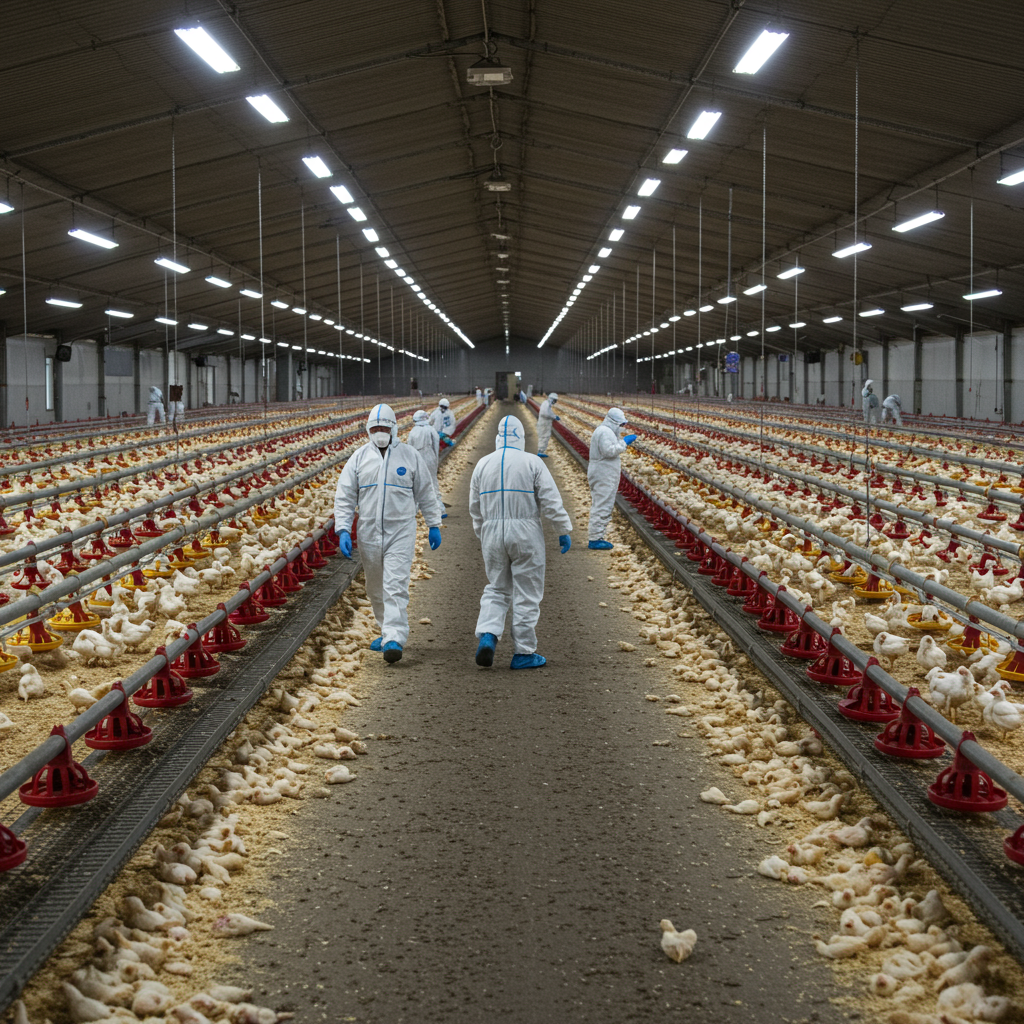Germany is currently facing an urgent and escalating avian influenza crisis. Since early September, a highly virulent strain of bird flu has necessitated the culling of over half a million birds, severely impacting both the country’s poultry industry and its wild bird populations. This widespread outbreak, predominantly driven by the H5N1 strain, presents significant economic challenges and raises critical questions about animal welfare, food supply, and global disease surveillance. The situation demands immediate attention as experts warn the peak of the outbreak may still be approaching, signaling a persistent challenge for authorities and stakeholders across the nation.
Germany Grapples with an Aggressive H5N1 Avian Influenza Outbreak
The current bird flu outbreak gripping Germany is characterized by its rapid spread and unusually early emergence. Typically, outbreaks intensify in November, coinciding with the peak migratory season. However, this year’s surge began in September, leading local authorities in regions like Rhineland-Palatinate to describe an “unusual dynamic” as new suspected cases arrive daily. The Friedrich Loeffler Institute (FLI), Germany’s central authority for animal disease monitoring, is actively tracking the situation, confirming the presence of the highly infectious H5N1 strain of the HPAIV influenza virus. This particular strain is known for its ability to transmit quickly and cause severe illness in birds. While H5N1 is the primary concern, broader surveillance in Europe has also detected the less prevalent H5N5 avian flu virus, highlighting a complex and multi-faceted viral threat.
Unprecedented Culling and Devastating Impact on Farms
The scale of culling in Germany has been alarming, with over 500,000 hens, ducks, geese, and turkeys euthanized since the outbreak began. This drastic measure is a standard protocol to prevent further viral transmission within commercial farms, but it carries immense financial and operational burdens for the agricultural sector. The FLI has confirmed at least 30 registered outbreaks in commercial poultry batteries, with figures constantly shifting as new infections are identified.
The severity of the situation has prompted calls for more stringent preventive measures. Hans-Peter Goldnick, head of the German Poultry Association, has urged for a federal mandate requiring all birds to be kept in their stalls, aiming to reduce contact with wild birds and minimize spread. This crisis also brings renewed attention to the “vulnerability of factory farming,” as highlighted by Germany’s opposition Green Party. Densely packed pens, a characteristic of industrial farming, create optimal conditions for rapid viral transmission once an infection is introduced, potentially exacerbating outbreaks.
Wild Birds Under Siege: Cranes Hit Hardest
Beyond commercial farms, Germany’s wild bird populations are enduring a severe impact. The FLI has reported over 70 outbreaks among wild birds, with thousands succumbing to the disease. Cranes, iconic migratory birds, have been particularly devastated. In regions like Linum, a village near Berlin renowned for its birdwatching, nearly 2,000 dead cranes have been recovered, and emergency services in northern Brandenburg have had to dispose of thousands of infected carcasses found strewn across fields.
This widespread affliction among cranes is particularly concerning to conservationists, as these birds are not typically heavily impacted by such outbreaks. Their unusual susceptibility to this strain of bird flu during their seasonal migration represents an alarming development. Volunteers, equipped with protective gear, are working tirelessly to collect deceased birds to curb further transmission, while other strategies, such as reducing resting areas for birds, are being explored to limit close contact and potential viral spread.
Geographic Hotspots: Where the Virus is Spreading
The current bird flu outbreak in Germany is geographically widespread, although certain regions have experienced a higher concentration of cases. The northern and eastern states are the most severely affected areas, reflecting the typical migratory routes and density of bird populations.
Key affected states include:
Lower Saxony: Reporting the highest number of confirmed cases, with 20 outbreaks.
Thuringia: Experiencing 19 confirmed cases.
Brandenburg: Also with 19 confirmed cases, and particularly impacted among wild crane populations.
Mecklenburg-West Pomerania: Recording 14 confirmed cases.
While these regions bear the brunt, the virus has also spread to other parts of the country. Bavaria in the south has reported eight cases, and North Rhine-Westphalia in the west has confirmed five, demonstrating the extensive reach of the current avian influenza wave across Germany.
Understanding the Risk: Bird Flu and Human Health
A crucial concern during any avian influenza outbreak is the potential for transmission to humans. According to the Robert Koch Institute (RKI), Germany’s federal agency for disease control and prevention, the risk of the current H5N1 outbreak spreading to humans remains low. There have been no recorded human cases linked to this specific event in Germany, although the virus is theoretically transmissible to humans in high doses.
However, the global context of H5N1 avian influenza underscores the need for continued vigilance:
Varying Human Symptoms: Globally, H5N1 infections in humans have historically had a high fatality rate (54%). However, a recent variant circulating in U.S. dairy herds resulted in unusually mild symptoms in 68 tested individuals, while other variants, particularly those from wild birds, have caused severe illness and fatalities, as seen in a Canadian teenager and an elderly American.
Potential for New Strains: Experts warn that simultaneous infection in humans with both H5N1 and common human H1N1 flu strains could lead to a “swapping of viral genetic material.” This process could potentially create new, more dangerous strains that combine the high lethality of bird flu with the easier transmissibility of human flu.
Proactive Measures: Countries like Canada have proactively acquired half a million doses of an H5N1 vaccine, targeting vulnerable populations such as farm workers, veterinarians, and medical staff who face a moderate risk of exposure.
Public Guidance: To mitigate direct exposure, the FLI strongly recommends avoiding contact with dead birds and ensuring that dirty boots are not worn near pens housing vulnerable animals.
Economic Repercussions and Food Supply Concerns
The widespread culling and ongoing threat of bird flu carry significant economic implications for Germany’s agricultural sector and potentially for consumers. The poultry industry faces substantial financial losses due to bird deaths, operational disruptions, and the costs associated with culling and disinfection.
The impact on consumer prices for poultry products and eggs is a subject of ongoing debate:
Price Hike Warnings: Robert Schmack, chairman of the Bavarian Poultry Union, has issued stark warnings, predicting a potential 40% to 50% increase in egg prices. He also anticipates a reduced selection of poultry products in supermarkets if the outbreak continues its current trajectory.
Tempered Expectations: Conversely, Hans-Peter Goldknick, president of the Central German Poultry Union, has expressed a more tempered outlook. He states he is “not expecting price explosions in the short term,” even in the run-up to Christmas. This perspective is partly attributed to Germany’s significant reliance on poultry imports, particularly geese from countries like Hungary and Poland, which can help buffer domestic supply shortages.
Historically, avian influenza outbreaks have led to devastating economic consequences. Past outbreaks across Europe have resulted in the culling of tens of millions of birds and severe financial losses, including millions of chickens and ducks lost in countries like the Netherlands and Poland. International trade is also impacted, with nations like Oman implementing bans on poultry imports from affected European countries, including Germany, to protect their domestic livestock.
Global Vigilance: Navigating a Persistent Avian Challenge
The current bird flu crisis in Germany is not an isolated event but part of a broader, persistent global challenge posed by avian influenza viruses. The “massive appearance of various bird flu viruses in Europe,” as noted by an FLI expert, underscores the dynamic and evolving nature of this threat.
Effective containment and management require multi-faceted strategies, as demonstrated by responses in other affected nations:
Enhanced Surveillance: Continuous monitoring of wild bird populations, passive surveillance in domestic poultry, and targeted surveillance following detections are crucial for early warning and rapid response.
Quarantine and Culling: Strict quarantine measures for infected farms and the humane culling of affected birds remain critical tools to prevent widespread transmission.
Import Restrictions: Regulating the import of bird by-products from high-risk regions helps control the international spread of the virus.
Public Health Involvement: Public health agencies play a vital role in managing potential human impact, ensuring safety protocols for farm workers, and conducting surveillance for human cases.
- Research and Development: Ongoing research into viral evolution, vaccine development, and alternative control methods is essential for long-term solutions.
- www.dw.com
- www.devdiscourse.com
- www.freemalaysiatoday.com
- nationalpost.com
- www.muscatdaily.com
The German government, in collaboration with scientific institutes and agricultural bodies, continues to monitor the situation closely, adapt its strategies, and implement measures to protect both animal populations and public health.
Frequently Asked Questions
What makes the current Germany bird flu outbreak so significant?
The current bird flu outbreak in Germany is particularly significant due to its early onset, beginning in September rather than the usual November peak, and its rapid, widespread nature. Over 500,000 birds have been culled since September, indicating a highly virulent H5N1 strain. The crisis affects both commercial poultry farms (over 30 confirmed outbreaks) and wild bird populations (over 70 outbreaks), with thousands of migratory cranes unusually impacted. This “unusual dynamic” suggests the outbreak may not yet have reached its peak, posing an ongoing severe threat to animal health and the economy.
Which areas of Germany are primarily affected by the H5N1 avian influenza?
The H5N1 avian influenza outbreak in Germany is widespread, but primarily affects the northern and eastern states. Lower Saxony has recorded the highest number of cases with 20, followed closely by Thuringia (19 cases), Brandenburg (19 cases), and Mecklenburg-West Pomerania (14 cases). These regions have seen significant culling and wild bird fatalities, particularly among cranes in Brandenburg. The virus has also spread to southern states like Bavaria (eight cases) and western states such as North Rhine-Westphalia (five cases), indicating its extensive reach across the country.
How might Germany’s bird flu crisis impact consumers and the economy?
Germany’s bird flu crisis could significantly impact consumers and the economy, primarily through the poultry and egg industries. With over half a million birds culled, a substantial reduction in domestic supply is anticipated. The chairman of the Bavarian Poultry Union warns of potential 40% to 50% increases in egg prices and a reduced selection of poultry products in supermarkets. While the Central German Poultry Union suggests no “price explosions” in the short term due to imports, historical outbreaks indicate severe economic losses for farms and potential disruptions to international trade, as seen with import bans from countries like Oman.
Conclusion: Navigating a Persistent Avian Challenge
The ongoing bird flu crisis in Germany represents a severe and multifaceted challenge, demanding sustained vigilance and coordinated efforts. The widespread H5N1 outbreak, marked by extensive culling, devastating impacts on wild bird populations, and significant economic uncertainty, underscores the fragility of agricultural systems and ecosystems alike. While the risk to human health remains low, the broader global context of avian influenza—including the potential for new viral strains and the need for proactive measures like vaccination—highlights the importance of robust surveillance and preparedness. As Germany navigates this persistent avian challenge, continued collaboration between government agencies, scientific experts, farmers, and the public will be crucial to mitigate further spread, protect livelihoods, and safeguard both animal and public health in the face of evolving viral threats. Staying informed and adhering to official guidance are essential steps for everyone during this critical period.



